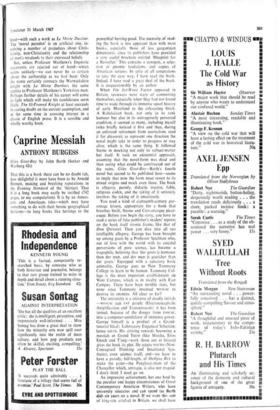Caprine Messiah
ANTHONY BURGESS
Giles Goat-Boy by John Barth (Seeker and Warburg 42s) That this is a book there can be no doubt (ah, how delightful it must have been to be Arnold Bennett, making and breaking reputations in the Evening Standard of the 'thirties). That it is a long book may easily be verified (742 pages, to my computation). It is by an Ameri- can, and Americans take—which may have something to do with their heroic geographical horizons—to long books like herrings to the
proverbial herring-pond. The necessity of read- ing the book is less apparent than with most books, especially those of less gargantuan dimensions, since its publishers have provided a very useful brochure entitled 'Blueprint for a Bestseller.' This contains a synopsis, a selec- tion of gnomic laudations, and copies of American reviews. In spite of all temptations to take the easy way, I have read the book. Indeed, I have read a great deal of the book. It is unquestionably by an author.
When The Sot-Weed Factor appeared in Britain, reviewers were wary of committing themselves, especially when they had not found time to wade through its immense spoof history of early Maryland to the exhausting finish. A Rabelaisian book, not only in its rank humour but also in its outrageously perverted erudition, it seemed to many, including myself (who briefly noticed it first and then, during an enforced retirement from journalism, read it for pleasure), to represent one direction the novel might take in order to progress or stay alive, which is the same thing. It followed Sterne in mocking not only its subject-matter but itself. It took an existential approach, assuming that the novel-form was dead and then seeing what could be constructed out of the ruins. Giles Goat-Boy—Barth's fourth novel but second to be published here—seems to imply that now the form must revert to its mixed origins and mock even those. The book is allegory, parody, didactic treatise, fable, religious codex, and the taking of it seriously involves the taking of it unseriously.
You need a kind of eighteenth-century par- sonage leisure, appropriate for a book that breathes Swift, Sterne and Cervantesque picar- esque. Before you begin the story, you have to read a series of fake publisher's readers' reports on the book itself (ironic frame, like that of Don Quixote). Then you dive into all too intelligible allegory. George has been brought up among goats by a Professor Spielman who, out of love with the world with its suicidal perversions of pure science, has become a tragophile, believing that 'der goats is humaner than der men, and der men is goatisher than der goats.' Equipped with a salvatory basic animality, George goes to New Tammany College to learn to be human. Tammany Col- lege is the most important establishment on West Campus, which is in rivalry with East Campus. There have been terrible riots, but none since Tammany invented WESCAC to destroy its enemies. All clear so far?
The university is a universe of deadly initials —wEscac can Ear people (Electroencephalic Amplification and Transmission): it has been turned, because of the danger from EASCAC, into a computer-annihilator of immense power. George himself is a product of a Grand- tutorial Ideal: Laboratory Eugenical Selection; hence GILES. His striving towards becoming a messiah or Grand Tutor (like Moishe, Enos Enoch and T'ang—work those out at leisure) gives the book its plot. He rejects Nocris (Non- Conceptual Thinking and Intuitional Syn- thesis), even science itself, and—we have to have a parody, full-length, of Oedipus Rex to make the point—the Panglossionism of the Chancellor which, untragic, is also not tragoid. I donY think I need go on.
An impressive achievement, but one bred by the peculiar and happy circumstances of Great Contemporary American Writers, who have university sinecures and can spend (as Barth did) six years on a novel. If we want this sort of king-size artefact in Britain, we shall have
to look, not to our professional writers, but to our dons. Giles Goat-Boy, like the architecture of a skyscraper, would be less impressive on a reduced scale. When Dr Johnson said of Gulliver's Travels that it was only a matter of thinking of little men and big men, sir, he threw out a seed of nasty truth along with the prejudiced fatuity. Giles Goat-Boy impresses more with its concept than (sheer mastery of length apart) its execution. And the concept is available to any clever undergraduate. On the other hand, self-criticism is built into the book, and any disparagement of mine has already been well taken care of. It makes much con- temporary British fiction look very lightweight. Interpret that in what sense you like.































 Previous page
Previous page